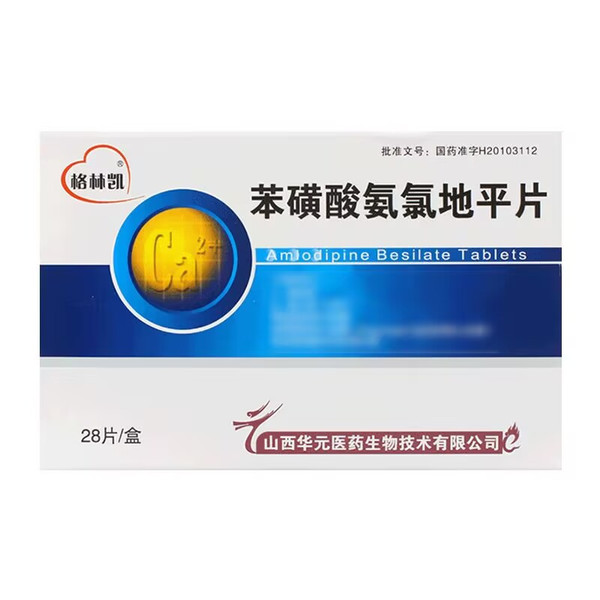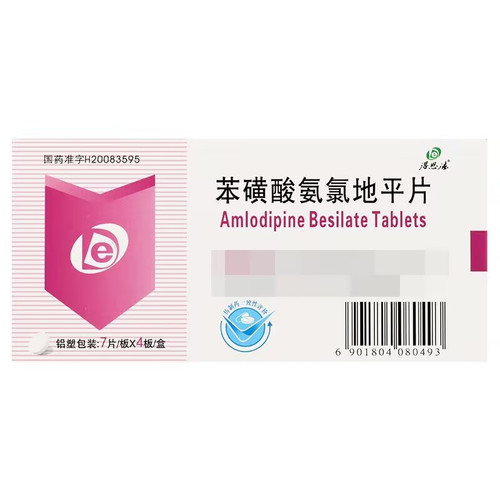Product Overview
[Drug Name]
Generic Name: Amlodipine Besylate Tablets
Trade Name: GeLinKai Amlodipine Besylate Tablets 5mg*28 Tablets
Pinyin Full Code: GeLinKai BenHuangSuanAnLvDiPingPian 5mg*28 Tablets
[Main Ingredients]
Amlodipine Besylate
[Indications/Main Functions]
1. Hypertension (used alone or in combination with other medications). 2. Angina pectoris: especially spontaneous angina (used alone or in combination with other medications).
[Specifications]
5mg*28 tablets
[Dosage and Administration]
The usual starting oral dose is 5mg once daily, with a maximum of 10mg once daily. Patients of a thin stature, frail constitution, elderly patients, or those with impaired liver function should start with 2.5mg once daily. Patients taking other antihypertensive medications should also start with this dose. The dosage should be adjusted based on individual needs, and the adjustment period should be at least 7-14 days to allow the physician to fully assess the patient's response to the dose. However, under the premise of clinical guarantee, the adjustment speed can be accelerated. The recommended dose for the treatment of angina pectoris is 5~10mg, and the dose needs to be reduced in elderly patients or those with impaired liver function.
[Adverse Reactions]
1. This product is well tolerated within the dose range of 10mg/day, and most adverse reactions are mild to moderate. Only 1.5% of patients discontinued this product due to adverse reactions, which was not significantly different from placebo (about 1%). The most common adverse reactions were headache and edema. 2. The dose-related adverse reactions with an incidence rate of >1% are as follows: edema, dizziness, flushing and palpitations. The dose relationship is unclear, but the incidence rate exceeds 1.0% as follows: headache, fatigue, nausea, abdominal pain and drowsiness. Among the above adverse reactions, edema, flushing, palpitations and drowsiness are more common in women than in men. 3. The incidence of the following adverse events is ≤1% but >0.1%, and the causal relationship with the drug is unclear. (1) General: allergic reaction, weakness, back pain, hot flashes, discomfort, pain, stiffness, weight gain. (2) Cardiovascular: arrhythmia (including tachycardia, bradycardia, or atrial fibrillation), chest pain, hypotension, peripheral ischemia, syncope, postural dizziness, postural hypotension, and vasculitis. (3) Central and peripheral nervous system: hypoesthesia, peripheral neuropathy, paresthesia, tremor, and vertigo. (4) Gastrointestinal: anorexia, constipation, dyspepsia, dysphagia, diarrhea, flatulence, pancreatitis, vomiting, and gingival hyperplasia. (5) Musculoskeletal system: arthralgia, arthritis, muscle cramps, and myalgia. (6) Psychiatric: sexual dysfunction, insomnia, tension, depression, nightmares, anxiety, and depersonalization. (7) Skin and appendages: angioedema, erythema, pruritus, rash, maculopapular rash. (8) Special senses: visual disturbances, conjunctivitis, diplopia, eye pain, tinnitus. (9) Urinary system: frequent urination, dysuria, nocturia. (10) Autonomic nervous system: dry mouth, night sweats. (11) Metabolism and nutrition: hyperglycemia, thirst. (12) Hematopoietic system: leukopenia, purpura, thrombocytopenia. 4. The incidence of the following adverse events is ≤ 0.1%: heart failure, irregular pulse, premature contraction, skin discoloration, urticaria, dry skin, dermatitis, hair loss, muscle weakness, tremor, ataxia, hypertonia, migraine, cold and wet skin, apathy, agitation, Forgetfulness, gastritis, increased appetite, loose stools, cough, rhinitis, dysuria, polyuria, parosmia, taste disturbances, visual accommodation disorders, and xerophthalmia. 5. Other occasional reactions, such as myocardial infarction and angina, cannot be distinguished as drug effects or disease states. 6. Routine laboratory tests showed no significant changes, including no significant changes in serum potassium, blood glucose, triglycerides, total cholesterol, high-density lipoprotein (HDL), uric acid, blood urea nitrogen, or creatinine. Post-marketing, there have been occasional reports of gynecomastia in patients taking the drug, but a causal relationship with the drug is unclear. In some cases, jaundice and elevated liver enzymes (often accompanied by cholestasis and hepatitis) have been severe, requiring hospitalization.









